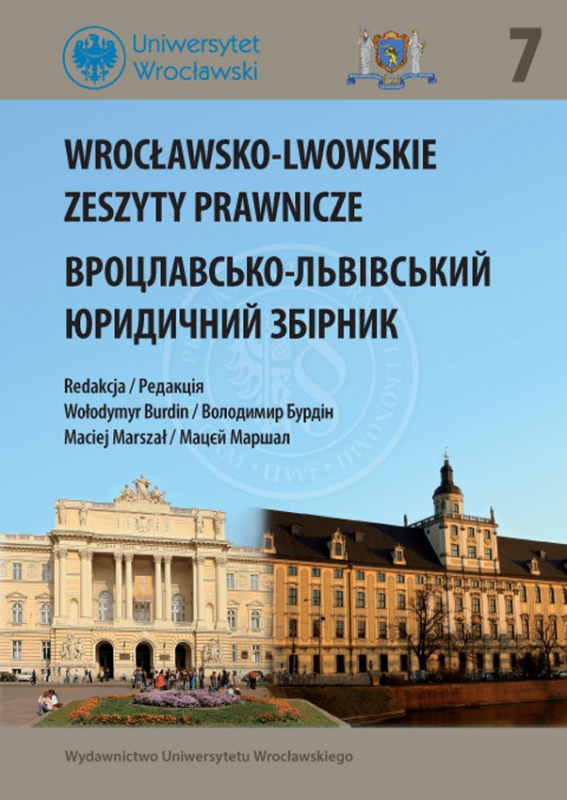

Artykuły

Objective features of intervention in the court activity accordingto the legislation of the Republic of Poland
The court statistics say only a few cases of conviction for intervention in the court activity took place. This is true both for the Republic of Poland and Ukraine. Thus, in 2014 in the Republic of Poland there were only 8 people convicted for this crime; in 2013 — 11 people; in 2012 — 38 people; in 2011 — 87 people. At the same time, the number of convictions for the same crime in Ukraine is only one or two persons.
In the article the object and objective side of this crime is analyzed according to the legislation of the Republic of Poland. The author concludes that the Polish legislator, just as the Ukrainian, defines justice in the broad sense, that is, as the courts and other law enforcement bodies and the narrow sense as only the activity of courts as special authorities. Material object of the offenses provided for in Section XXX of the Criminal Code of the Republic of Poland is justice in the broadest sense of the word. Individual subject of this crime is justice in the narrow sense of the word.
Victims of this crime may be a person or several persons who exercise their functions relating to the administration of justice. Polish scientists say that the victims of this crime can be a judge, juror or assessor.
Intervention in the court activity under the laws of the Republic of Poland can be committed in two ways: by causing undue violence or by threats. Thus, violence can be both direct, that is, physically affecting the body, and indirect, by affecting the material world.
The term “unlawful threats” has a legal definition stipulated in § 12 Art. 115 of the Criminal Code of the Republic of Poland. Under this rule, illegal threat is both a threat that is provided in Art. 190 of the Criminal Code of the Republic of Poland and the threat of taking measures for the opening of criminal proceedings, the disclosure of information defaming a person or his close relative. It is not an unlawful threat to announce the arrangements for the opening of criminal proceedings, which is intended to guard the law violated by the crime.
Unlawful threat can be expressed both orally and in writing, or in a different manner.
Ingerencja podmiotów pozasądowych w działalność sądów w świetle ustawodawstwa Rzeczypospolitej Polskiej
Statystyki sądowe stwierdzają pojedyncze przypadki skazania osób odpowiedzialnych za wywieranie wpływu na czynności sądowe. Jest to zjawisko charakterystyczne dla obu państw, zarówno dla Rzeczypospolitej Polskiej, jak i Ukrainy. I tak, np. w 2014 r. w Polsce za przestępstwo przeciwko wymiarowi sprawiedliwości polegające na wywieraniu wpływu na czynności sądowe skazano 8 osób, w 2013 r. — 11 osób, w 2012 r. — 38 osób, w 2011 r. — 87 osób. Jednocześnie liczba skazań za to samo przestępstwo na Ukrainie wynosi 1–2 osoby.
W artykule autor analizuje przyczyny przestępstw wywierania wpływu na czynności sądowe. Stwierdza, że ustawodawca polski, podobnie jak ukraiński definiuje wymiar sprawiedliwość w szerokim znaczeniu tego słowa, czyli jako działalność sądów i innych organów ścigania oraz w wąskim znaczeniu jako jedynie działalność sądów. Rodzajowym przedmiotem przestępstw, przewidzianych w rozdziale XXX Kodeksu karnego RP jest ingerencja w wymiar sprawiedliwość w najszerszym znaczeniu tego słowa. Bezpośrednim przedmiotem tego przestępstwa jest ingerencja w wymiar sprawiedliwość rozumiany w wąskim znaczeniu tego słowa, tj. jako ingerencja w działalność sądu.
Ofiarą omawianego przestępstwa może być osoba lub kilka osób, które sprawują swoje funkcje w wymiarze sprawiedliwości. Według prawników polskich ofiarą może być: sędzia, ławnik lub asesor. Jako przestępstwo dokonywane na wymiarze sprawiedliwości uznawane jest: stosowanie przemocy lub groźby jej użycia.
Definicja „bezprawnej groźby” jest określona w § 12, art. 115 Kodeksu karnego RP. Zgodnie z tym przepisem groźbą bezprawną jest zarówno groźba, o której mowa w art. 190, jak i groźba spowodowania postępowania karnego lub rozgłoszenia wiadomości uwłaczającej czci zagrożonego lub jego osoby najbliższej; nie stanowi groźby zapowiedź spowodowania postępowania karnego, jeżeli ma ona jedynie na celu ochronę prawa naruszonego przestępstwem. Groźba bezprawna może być wyrażona zarówno ustnie, jak i pisemnie lub w inny sposób.